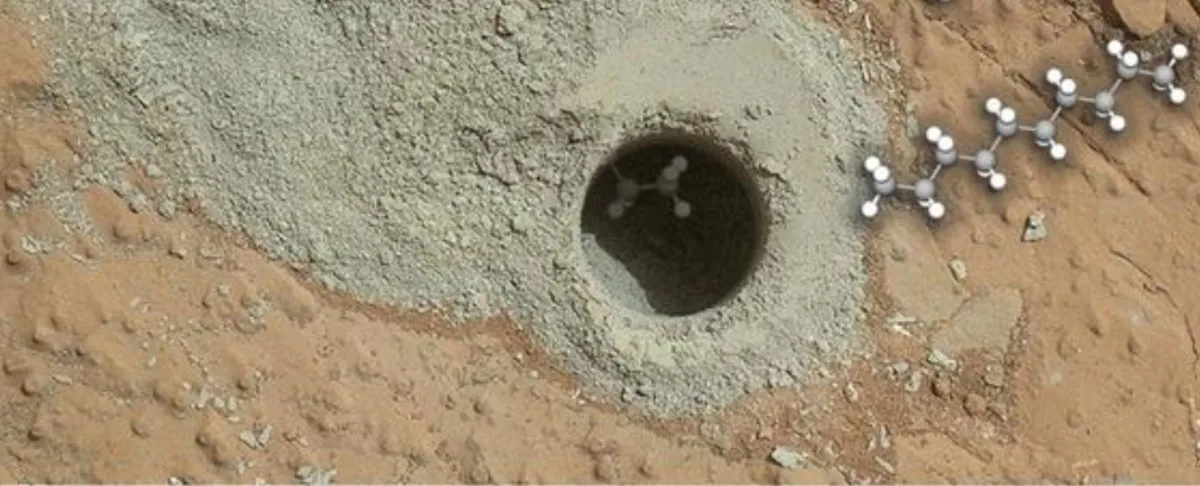
Recent findings from NASA's Curiosity rover have revealed the presence of carbon chains consisting of up to a dozen carbon atoms in what seems to be an ancient lakebed on Mars. This discovery adds to the expanding library of compounds that may provide crucial insights into the history of life on the red planet. The analysis was carried out by a specialized sampling instrument aboard the Curiosity rover, with confirmation achieved by an international team of researchers in a laboratory setting on Earth.
The groundbreaking research was spearheaded by analytical chemist Caroline Freissinet from the French National Centre for Scientific Research (CNRS). While the detected compounds could have originated from non-biological processes, their mere existence underscores the rover's capability to identify long organic molecules on the Martian surface, potentially formed billions of years ago.
Freissinet explained to ScienceAlert that the survival of these fragile linear molecules on Mars for 3.7 billion years allows scientists to make an intriguing assertion: if life ever existed on Mars billions of years ago—around the same time life emerged on Earth—chemical remnants of that ancient life could still be detectable today. The primary objective of the Curiosity rover is to gather evidence that suggests whether Mars ever harbored life or came close to doing so.
Curiosity's slow navigation across the sedimentary rocks of Gale Crater has led it to encounter a variety of intriguing deposits, including different chlorinated and sulfur-containing organic compounds and nitrates. These findings indicate the potential for discovering even more complex signs of life within the ancient Martian rock.
The researchers employed an experimental procedure using a chemical enhancer to analyze mineral samples collected from a mudstone deposit called Cumberland. The analysis involved heating the samples to approximately 850 °C (1,562 °F) during a gas chromatography–mass spectrometry (GC-MS) procedure, which helped to minimize combustion risks by cooking off molecular oxygen.
Among the results were several of the longest carbon chains identified on Mars to date, including minuscule concentrations of saturated hydrocarbons known as decane (C10H22), undecane (C11H24), and dodecane (C12H26). The team conducted a series of analytical experiments under controlled laboratory conditions, demonstrating how Mars-like mineral environments could generate these carbon chains from other organic compounds, such as benzoic acid.
The research indicates the presence of linear carbon chains—referred to as alkanes or hydrocarbons—differentiating them from previously detected aromatic molecules, which are circular in structure and contain a maximum of six carbon atoms. Since circular rings are more stable than linear molecules, the presence of these compounds in rock might suggest they were formed from simpler molecules like hydrogen and carbon monoxide without any biological assistance.
Nevertheless, it remains captivating to contemplate the possibility that these carbon chains could be remnants of more complex compounds that signify biological activity. Human bodies, for instance, contain a diverse array of carboxylic acids that might be preserved in Mars' sedimentary rock. While abiotic processes can produce these acids, they are typically viewed as universal products of biochemistry, both terrestrial and potentially Martian.
This latest discovery highlights that our current technology can effectively probe the chemistry of Mars. However, the quest to determine whether any form of life is fossilized or even surviving deep beneath the Martian surface—where water might still be present—will likely require future exploratory missions. Insights gained from findings such as these will undoubtedly guide and inform those upcoming endeavors.
For now, scientists and enthusiasts alike are encouraged to indulge in the wonder of the possibility that these long chains of carbon could once have been part of a life form that evolved on another world. The exploration of Mars continues to offer tantalizing hints about the potential for life beyond our planet, igniting curiosity and hope for future discoveries.